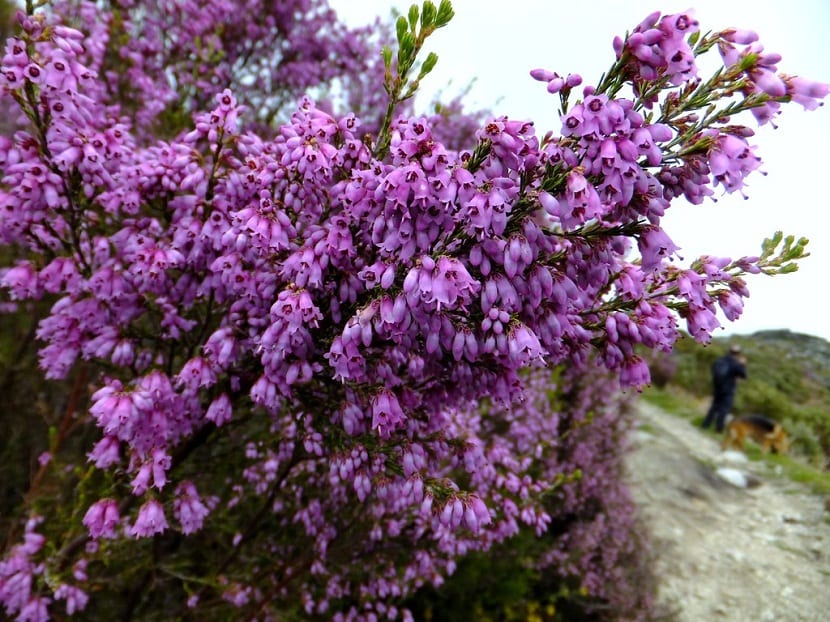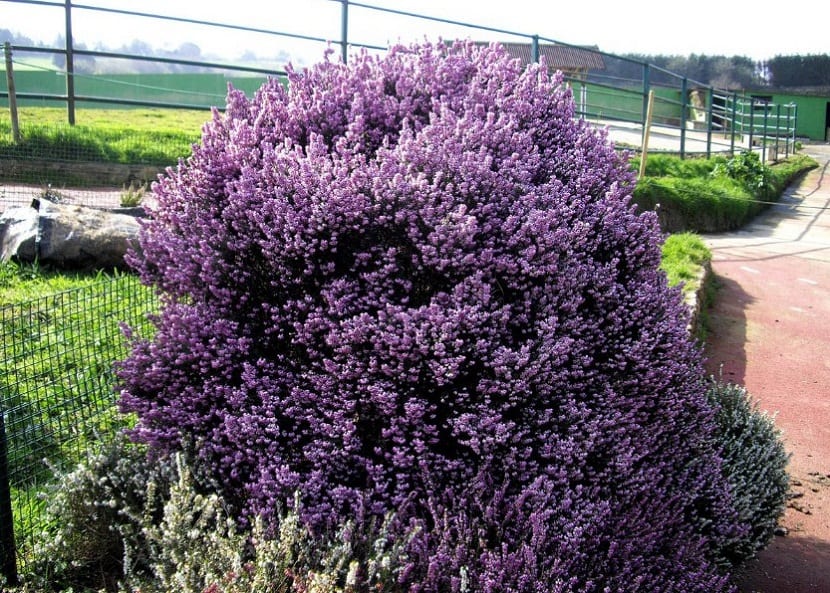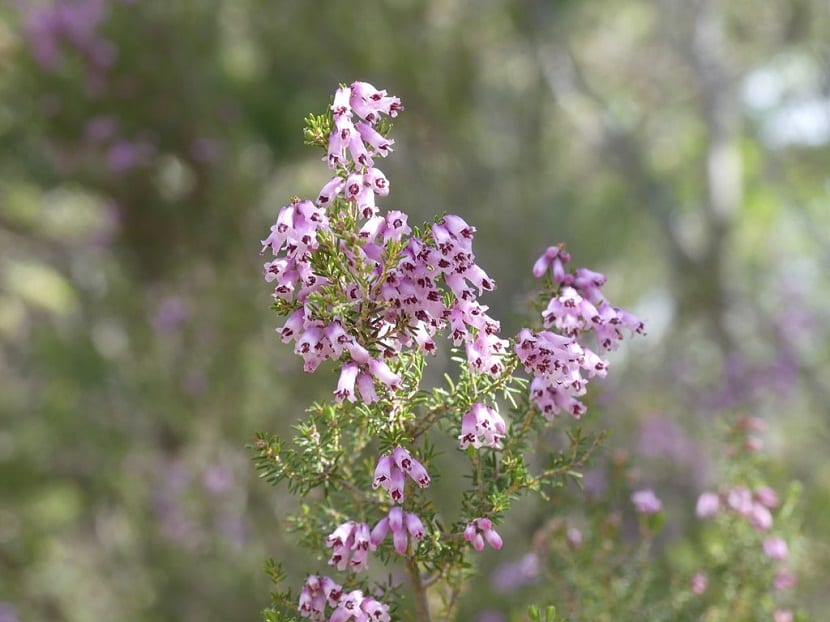
La erica australis, is a plant belonging to the Ericaceae family. The word Erica comes from the old Greek term "erica", used by Theophrastus to refer to some plants of the Mediterranean region and today, the term is used by many authors, but officially only to describe the genus.
Like other heather, cultivated as an ornamental plant primarily for its lush and attractive flowering. This species is so abundant that it is used regularly and its flowers are considerably visited by bees.
Origin and habitat

In the wild it can be seen in the Iberian Peninsula and North Africa. In the Peninsula it is distributed in the north, center and west region. It is one of those heather species that abound in acid soils, derived from sandstone from the Strait of Gibraltar region (southern Spain and northern Morocco).
In its habitat it prefers poor and shallow soils, with a high content of soluble aluminum, generally that found in mountain ranges and peaks. In unfavorable soils for agriculture, bushes are seen where red heather predominates as it is commonly known.
Features erica australis
La erica australis It is a very straight shrub that can exceed 1.5 m in height, its young branches can reach up to 1.5 m or they can be slightly taller with young branches that create a crown. With 3.5 to 6 mm radiant green leaves, obtuse and linear, the underside feels a bit rough at first and then more smoothing. The base of the leaves is short and they have 1 to 4 whorls.
Its flowers are oriented towards the same side and have a calyx with four oval sepals, slightly membranous, of a reddish color, glabrous. The corolla measures approximately 6 to 9 mm, tubular, somewhat curved, with a dilated apex and four ovoid lobes. The stamens are close together, having two somewhat deviated appendages at the base of the anthers.
The carpel of this plant has stigma and in warm regions, its flowering occurs between spring and summer, while in other areas, it blooms practically throughout the year.
Planting and care
All species of this genus you can multiply them by seed or graft. Its seedlings can be planted in permanent places, preferably after one and a half or two years of life.
With regard to seed reproduction, this is a time-consuming technique. First of all sufficiently prepare the soil, since it must contain a part of conifer, two parts of soil for heather and a part of sand, then you cover it with a plastic. The temperature should be cool, below 18 ° C.
Water the soil daily with warm water. The germination process can be long, since it can take more or less 1 month. Once the sprouts appear, they grow a little and gradually get used to the sunlight. The definitive strengthening of the seedlings occurs after approximately 2 months.

The advantage offered by reproduction by cuttings is that with the use of this method the plant blooms much faster than those produced by seeds. For this, cut the upper part of the shoots collected during the fall, these must be previously moistened, then plant them in a mixture of sand and peat. Make sure the ground is moist and the ambient temperature is within a cool range of 18 to 20ºC. Meanwhile, they must remain protected from the direct rays of the sun.
After about a quarter, you will see that the seedlings will show their roots. It is the right time for the fences to be progressively placed under the sun and fresh air. This adaptation stage takes a month. Afterwards it can be planted in the definitive place that you have in mind for it.
Remember that Red Heather requires good drainage because it does not tolerate stagnation of water, otherwise it will not grow properly. Similarly, avoid areas where snowfall accumulates. For this species to keep its leaves and flowers in good condition, it requires good sunlight. It does not need to be placed in shady areas prone to gusts of wind.
Now, if you add some river sand, it will keep for years. Caring for this species is not difficult, all you need is watering, fertilizing and pruning its suckers after flowering. In the home, you must be careful with the arrival of frostFor this reason, before starting, cover the plantations with dry leaves or fir leaves. This will ensure a good winter and give the soil the necessary nutrients.
Natural fertilizers are usually applied during the sowing period, before flowering and after pruning. It can be applied by adding it to irrigation water. It is important to loosen the soil and add a cover that can be pine bark, chips and peat.
As you know it is a species that tolerates periods of droughtHowever, it is advisable to include frequent watering, always trying to keep the soil sufficiently moist. The water for irrigation must be at a certain temperature. If the plant is grown in a pot, then you can immerse it in water for about half an hour. As it is somewhat sensitive to ambient humidity, it periodically sprays the soil to counteract the effects.
Uses
Thanks to its almost permanent flowering, Red heather is preferred by gardeners and homeowners for rock gardens and flower beds. Landscapers use it to cover floors. Its flowering can be used equally for individual compounds or group plantations. It is definitely a recognized species for garden decoration.
In natural medicine its use is known in countries such as Turkey and Morocco, especially, its stems, leaves and flowers that are used as diuretics, astringent, laxative, urinary disinfectant and against the common cold. It is also used for the treatment of hyperlipidosis and to lose weight..
In North Africa it is used to treat inflammation and blood pressure. In the north of Portugal, its inhabitants use it for the treatment of urinary tract diseases, such as prostatic hypertrophy and bladder and kidney conditions.
Diseases and pests

La erica australis it is a plant prone to fungal and viral diseases. Among the diseases caused by fungal fungi is the typical gray rot. The first visible symptoms are the fall of its leaves, where the flowers turn gray and the death of the youngest shoots.
However, the good news is that a number of antifungal insecticides are now available in specialty stores to successfully combat gray rot. Generally, the treatment used is applied for 5 to 10 days.
Regarding the use of fumigation, this should be done during the autumn and spring times, using antifungal insecticides. Regarding the possible attack of pests, this plant is quite resistant. However, to avoid potential damage, stems and leaves can be carefully treated with a mildly applied alcoholic solution. The areas infected by the pest can be treated with specific products.